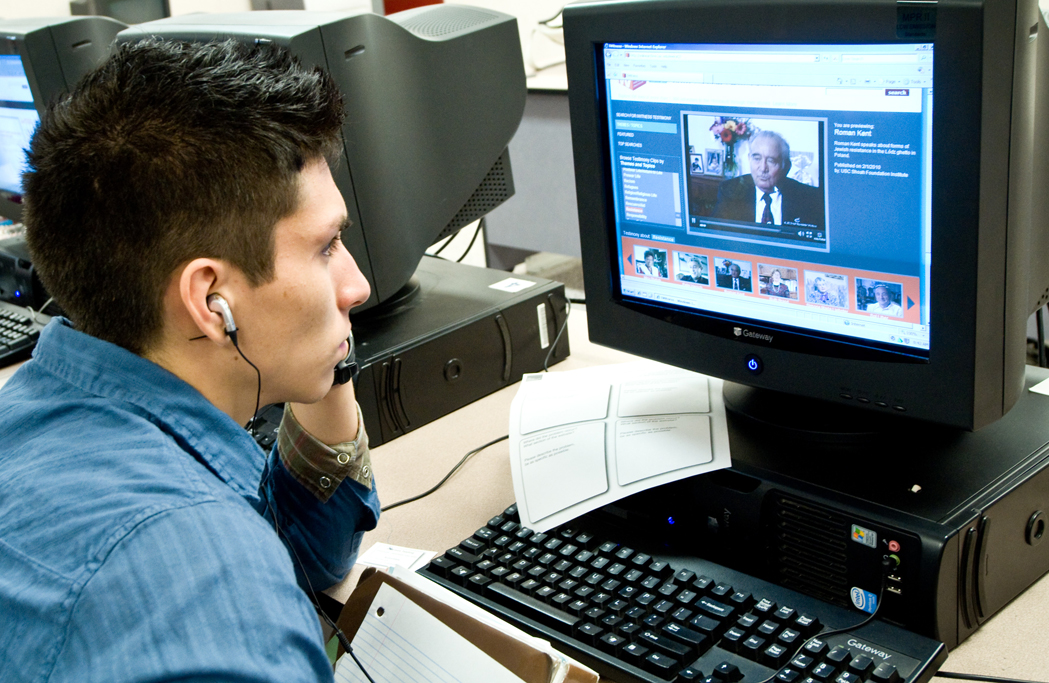From Viral Video to Ethical Editing

What students need to know about working with testimony
By Holly Willis
Three years ago, the Institute for Multimedia Literacy, a research unit within the University of Southern California’s School of Cinematic Arts and that is designed to study new forms of literacy in a digital culture, embarked on a collaboration with USC Shoah Foundation—The Institute for Visual History and Education. The goal of the collaboration was to develop best practices for teaching students how to work with clips of testimony from the Institute’s Visual History Archive. As the Institute continued to expand its outreach to high school students, undergraduates, and graduate students, and as students began to watch, edit, combine, and reconfigure these clips, what did they need to know?
Our attention to this topic stemmed from the simple fact that our students come to us now with a tremendous amount of experience viewing, sharing, creating, and uploading online video. Indeed, the ability to take images, manipulate them, and recirculate them is shared by anyone with access to a computer and the internet. However, much of the material that our students engage with in this context is viral video, which tends to spark laughter or shock more often than contemplation; it moves quickly from source to source as short-lived memes, and it may be valued more for its spreadability than for its intellectual complexity. The result is a kind of “video vernacular” and a correspondingly cavalier attitude toward visual material viewed online.
This attitude isn’t appropriate when students are invited to engage with sensitive materials. As students began to work with clips of testimony, we needed a method that teachers could adopt and which would inspire careful attention to notions of truth, care, and respect. We knew that this attention could only come through the development of an understanding specifically of editing and what it means to excerpt a clip, place it in juxtaposition with another clip, and even to compile a sequence of excerpted clips that, in their placement, create meaning. With this in mind, together we developed the notion of ethical editing: the act of selecting, combining, and presenting clips of testimony in a manner that honors and respects the truth, considers interviewees’ possible vulnerability, and acknowledges the viewers’ trust.
We reasoned that if students could apply this definition to their work with clips of testimony, not only would their own thinking about the material grow more nuanced, but it would also result in more careful video projects. To help students consider the ethics of editing in more detail, we also introduced basic concepts from documentary filmmaking.
First, documentary films endeavor to represent the truth. They make a “truth claim.” Viewers accept this claim as a kind of contractual obligation on the part of the filmmaker, and the filmmaker in turn struggles constantly with a commitment to convey the truth. This applies to working with clips of testimony and creating sequences that use this material.
Second, documentary filmmakers must establish a point of view toward the material presented. There are many ways to frame documentary material: Do you simply present a series of clips, without any overt perspective, and leave interpretation to your viewers? Or do you make your perspective clear, either through text or voice-over, so that your viewers will make no mistake with regard to your intentions? Do you use music to help produce an interpretation, or suggest your own perspective? What about slow fades, or a zoom to highlight a particular aspect of a shot? Each of these activities contributes to the creation of point of view.
Third, documentary filmmakers establish a particular stance, or attitude, toward their material. This is far more subtle than point of view, and reflects the maker’s opinions, emotions, and ideological positioning. For this concept, we invited students to consider their own stance, and to think about how they feel about the material they are presenting, not simply what they think. Clips of testimony can incite an array of complex and often conflicting emotions, which in turn will affect a student’s stance, and the decisions regarding what is presented and how. These require some reflection.
As participants in a visual culture, we approach the act of editing with a great deal of skill already, even if we have never once made an editorial decision. We know almost intuitively how to combine images to tell a story, and how to use basic editing techniques—such as dissolves, fades, and fast cutting—to convey meaning using our culture’s visual vernacular. However, we believe that is important to take the opportunity presented by the special circumstances of clips of testimony in the Visual History Archive to slow down, to analyze, to question, and possibly to invent a new visual language appropriate to the kinds of meaning-making particular to the testimonials. With this in mind, we concluded our various working sessions with teachers by pointing to a key challenge: how can we mobilize the excitement and enthusiasm of our students as they engage with video in an entirely new context to imagine a visual language specific and appropriate to their projects? With this in mind, we look forward to the emergence of a new genre of video essay built on clips of testimony and informed by ethical editing.
Holly Willis is a faculty member in the School of Cinematic Arts at the University of Southern California, where she also serves as director of Academic Programs for the Institute for Multimedia Literacy and Director of the Media Arts + Practice PhD program. As part of her work Willis teaches, organizes workshops, and oversees academic programs designed to introduce new media literacy skills across USC’s campus and curriculum. She is the editor of The New Ecology of Things (Art Center College of Design, 2007) and the author of New Digital Cinema: Reinventing the Moving Image (Wallflower Press, 2005).
This article first appeared in the Summer 2013 issue of PastForward, the Institute's digest.